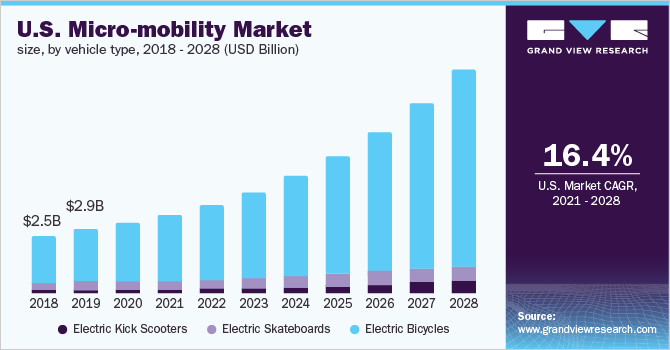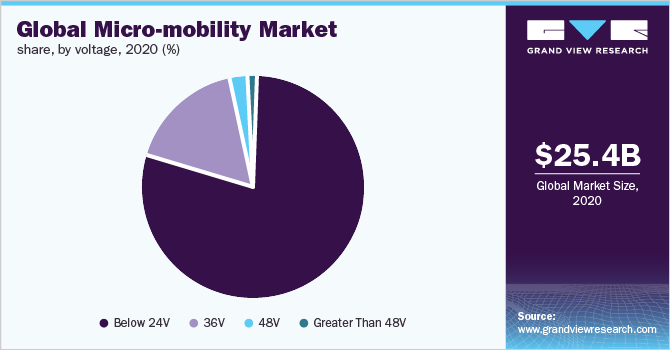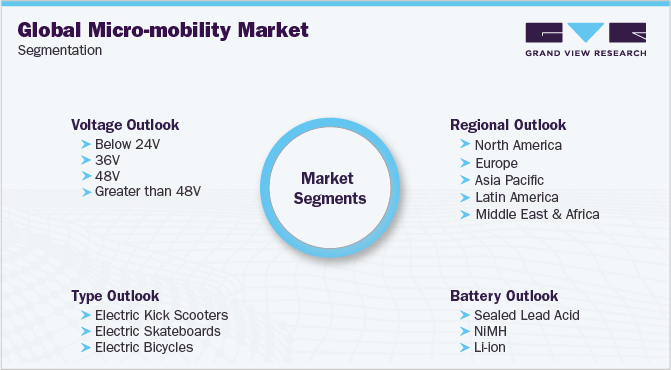- Home
- »
- Automotive & Transportation
- »
-
Micromobility Market Size, Share, Trends & Growth Report, 2028GVR Report cover
![Micro-mobility Market Size, Share & Trends Report]()
Micro-mobility Market Size, Share & Trends Analysis Report By Vehicle Type (Electric Kick Scooters, Electric Skateboards, Electric Bicycles), By Battery, By Voltage, By Region, And Segment Forecasts, 2021 - 2028
- Report ID: GVR-4-68038-303-4
- Number of Pages: 112
- Format: Electronic (PDF)
- Historical Range: 2018 - 2019
- Industry: Technology
Report Overview
The global micro-mobility market size to be valued at USD 69.32 billion by 2028 and is expected to grow at a compound annual growth rate (CAGR) of 13.7% during the forecast period. Micro-mobility is an evolving field of transportation that includes travel undertaken using a range of light vehicles such as electric kick scooters, electric skateboards, and electric bicycles. Factors such as increasing road congestion, rising oil & gas prices, ease of parking, and saturation within the automotive sector are expected to drive market growth during the forecast period. Furthermore, factors such as the growing electric bicycles and electric kick scooter renting and sharing services across the globe are expected to create new opportunities for micro-mobility in the forthcoming years.

In 2020, the market recorded a negative impact owing to the pandemic. The stringent measures and recent lockdown to contain the coronavirus have hindered the retail business activity of micro-mobility vehicles across the world. The COVID-19 pandemic has rigorously disrupted manufacturing operations and supply chains. This situation is mainly challenging for micro-mobility vehicle manufacturers and dealers. However, the fear of public transportation encouraged some customers to commit to purchasing micro-mobility devices during 2020-21. The post-COVID environment is expected to accelerate the transition to more sustainable mobility.
The increasing greenhouse gas emissions have led to the implementation of several initiatives to reduce climate change, enabling policymakers to place hopes on electric vehicles. This has led to the enactment of an action plan for climate change to reduce the emissions from transportation by adopting sustainable and eco-friendly transportation alternatives such as public transport and electric vehicles. Furthermore, the rising investments in clean energy and the initiatives undertaken by governments for curbing CO2 emissions are expected to boost the demand for electric kick scooters, electric skateboards, and electric bicycles.
Many governments are setting regulations, objectives, and policies for micro-mobility deployment; encouraging OEMs and other industry stakeholders to actively participate in the industry, and building confidence by mobilizing investments and policy frameworks. For instance, electric kick scooters are legal in Canada. They generally require no insurance, license, or number plates to operate in Canada. Similarly, in the U.S., electric kick scooters are permitted on roads, the nonexistence of bicycle lanes, if they do not surpass the speed limit of 25 miles per hour.
Different U.S. states have separate specifications for electric kick scooters. Additionally, micro-mobility vehicles have become a cost-effective urban commute for an end-user. Sleek design and easy handling capability help commuters avoid traffic congestion and simultaneously reduce carbon emissions. The abovementioned factors are some of the key drivers escalating the adoption of micro-mobility vehicles. Since the shared micro-mobility service industry is currently undergoing rapid development and is in a transition phase, the electric kick scooters sharing operators are also focusing on expanding their presence in both untapped and competitive markets.
Micro-mobility Market Trends
The element driving the expansion of ride-sharing and ride-hailing services is due to the huge increase in the choice of bike pool and carpool services among office-goers. Furthermore, the expansion of services provided by key market players such as Ola and Uber and the ability to select convenient pick-up and drop-off locations are pushing customers to use ride-sharing and ride-hailing services. Additionally, the expansion of micro-mobility industry is fuelled by a considerable increase in the number of the various ride-sharing and ride-hailing services such as auto-sharing and bike-sharing even for short-distance travel.
The demand for micro-mobility systems is increasing as a result of the rise in value of gas and oil due to economic and geo-political concerns. These automobiles are eco-friendly and affordable. People all around the world are looking for a low-cost, clean substitute for conventional fuel. These are some of the key market drivers driving the market. Moreover, the usage of micro-mobility cars to travel saves both money and time. The demand for these vehicles is increasing in the urban areas which is anticipated to bolster the market growth.
However, the low internet penetration in developing countries and an increase in bike stealing or damage are limiting the worldwide micro-mobility market's growth. Furthermore, the most frequent form of micro-mobility is carpooling, which burdens passengers with their privacy when traveling. As a result, many customers feel insecure about ridesharing services. Some countries throughout the world, including Germany and Japan, have banned ridesharing services because of significant resistance from local taxi businesses.
Furthermore, advanced transportation systems and rising government initiatives to create bike-sharing infrastructure is expected to provide many opportunities for the global market to grow throughout the forecast period.
Vehicle Type Insights
Based on vehicle type, the market is segmented into electric kick scooters, electric skateboards, and electric bicycles. The electric bicycles segment dominated the market in 2020 and accounted for more than 85% of the global revenue. The segment is projected to register a CAGR of over 14.3% over the forecast period as they are the most affordable and convenient alternatives to public transportation. Several countries are working toward boosting the use of electric bicycles using both regulatory and subsidies changes to decrease the stress on public transportation systems. Furthermore, compared to other transportation systems such as buses and cabs, electric bicycles are easy to charge, inexpensive, and do not require large investments in supportive infrastructure. Hence, an increase in the demand for electric bicycles across the world is being observed.
The electric kick scooters segment is anticipated to record the second-highest CAGR of 10.3% over the forecast period. The demand for these scooters has increased since 2017 owing to large investments by players in the electric scooter-sharing market as it is still in the transition phase. The scooter-sharing market is currently witnessing a dynamic shift with the entry of global players such as Uber Technologies, Inc.; Bird, Inc.; Lyft; and Lime operating in the on-demand transportation industry.
Battery Insights
Based on battery, the market is segmented into sealed lead-acid batteries, Nickel-Metal Hydride (NiMH) batteries, and Lithium-ion (Li-ion) batteries. The sealed lead-acid battery segment dominated the market in 2020 and accounted for more than 55.0% of the global revenue. The segment is projected to register a CAGR of over 12.6% over the forecast period. These batteries are the preferred alternatives for manufacturers due to their cost-effectiveness. Additionally, their low self-discharging capability and ease of manufacturing are fueling their adoption of electric vehicles. However, the raw materials used for manufacturing these batteries include high toxic substances that release millions of tons of lead into the environment. This negative impact on the environment has led manufacturers to adopt alternative options for batteries, thereby leading to a comparatively slow segment growth over the forecast period.
The growing awareness of adopting eco-friendly batteries for their better performance, over sealed-lead acid and NiMH batteries has boosted the demand for Li-ion batteries. Since these batteries are high priced compared to the other two battery types, their adoption has resulted in an increased price of electric vehicles in the emerging markets. However, with increasing advancements in technology and growing demand for these batteries, the price of Li-ion batteries is reducing. The cost of lithium-ion batteries is expected to reduce annually by 6.5% over the next decade, thus directly impacting the price of electric vehicles. Therefore, the segment is expected to grow swiftly over the forecast period.
Voltage Insights
Based on voltage, the market is segmented into below 24V, 36V, 48V, and greater than 48V. The below 24V segment dominated the market in 2020 and accounted for more than 75.0% of the global revenue. It is anticipated to continue to dominate the market over the forecast period. Micro-mobility vehicles such as skateboards, scooters, and bicycles usually use less than 24V batteries, such as 12V or 18V rechargeable batteries, which provide enough power required for their motors and a low range of electric vehicles compared to other vehicle types. Electric vehicle manufacturers use sets of 12V or 18V lithium-ion batteries instead of sealed lead-acid batteries to reduce the weight of the vehicle and improve its overall efficiency.

The 36V segment is anticipated to register the highest CAGR of 14.0% over the forecast period. The integration of 36V systems in electric vehicles not only increases the distance range but also improves the performance of the vehicle. The use of 36 V batteries is mainly catered through NiMH and Li-ion batteries as they are compact, offer better charging time, and do not release harmful chemicals compared to sealed lead-acid batteries.
Regional Insights
The Asia Pacific region dominated the market in 2020 and accounted for over 45.0% share of the global revenue. Most players manufacturing micro-mobility vehicles operate in Asia Pacific, Europe, and North America regions. These players generate revenue by selling their products internationally, either through their distribution channels or through the OEM channel. The governments of economies such as India, China, and Japan are setting up standards and regulations for vehicle charging infrastructure and this is expected to have a positive impact on the regional market growth. Additionally, Asia Pacific is expected to emerge as the fastest-growing regional market over the forecast period.

Consumer demographic features vary among different regions. Electric kick scooter drivers from North America and Europe tend to perceive electric kick scooters more as a lifestyle while those from Latin America, the Middle East and Africa, and the Asia Pacific use electric kick scooters more as practical transportation means. Consumer satisfaction, which can be measured with various parameters such as performance, maintenance expense, and durability, is an essential factor for the vendors trying to retain existing customers or to attract new customers. However, vendors trying to attract consumers during the launch of any vehicle focus on two main factors, namely design/style and specifications.
Key Companies & Market Share Insights
The key market players such as Yadea Technology Group Co., Ltd.; JIANGSU XINRI E-VEHICLE CO., LTD.; Xiaomi; SEGWAY INC.; SWAGTRON; Boosted USA; Air wheel Holding Limited; YAMAHA MOTOR CO., LTD.; Accell Group; and Derby Cycle are continuously pursuing various initiatives such as strategic partnerships, mergers and acquisitions, and new product launches. These vendors hold expertise in the micro-mobility industry and have strategic footprints spread across various parts of the world. Hence, these companies have been able to successfully defend their position in the market. At the same time, small and niche vendors are also introducing micro-mobility vehicles with an extended range. As a result, the competition is gradually intensifying and prompting market players to pursue various initiatives, including strategic partnerships, mergers and acquisitions, and new product launches, to cement their position in the market.
The market has witnessed several new product launches in recent years. For instance, in July 2020, Xiaomi launched Ninebot C30, an electric scooter in China. The scooter is compact with a range of up to 35 km and a top speed of 25 km/h. Similarly, in April 2020, Xiaomi launched Mi Electric Scooter 1S, which was made available across China's e-commerce platforms and offered shipping options internationally. The scooter has a range of 30 km on a full charge with a maximum speed of 25 km/h.
Some of the prominent players operating in the global micro-mobility market are:
-
Yadea Technology Group Co., Ltd.
-
JIANGSU XINRI E-VEHICLE CO., LTD.
-
Xiaomi
-
SEGWAY INC.
-
SWAGTRON
-
Boosted USA
-
Airwheel Holding Limited
-
YAMAHA MOTOR CO., LTD.
-
Accell Group
-
Derby Cycle
Recent Developments
-
In March 2022, Segway-Ninebot launched the new Segway GT-series, P-series, and E110A. The product helped to satisfy the changing needs of modern transportation., with reliability and sustainability by allowing riders to travel in comfort and style.
-
In June 2022, Porsche expanded its electric bike business by purchasing new models from the manufacturer of electric bicycles in Germany. The joint venture focuses on the development, production, and distribution of a new generation of high-quality Porsche e-bikes
-
In May 2022, Nashville's transit gaps are be filled via public transportation and micro-mobility integration. As a mobility coordinator, the company sees collaborations with micro-mobility providers like Bird as possibilities to broaden its function from just a transit provider to a mobility coordinator
Micro-mobility Market Report Scope
Report Attribute
Details
Market size value in 2021
USD 28.18 billion
Revenue forecast in 2028
USD 69.32 billion
Growth Rate
CAGR of 13.7% from 2021 to 2028
Base year for estimation
2020
Historical data
2018 - 2019
Forecast period
2021 - 2028
Quantitative units
Revenue in USD Billion and CAGR from 2021 to 2028
Report coverage
Revenue forecast, company ranking, competitive landscape, growth factors, and trends
Segments covered
Vehicle type, battery, voltage, region
Regional scope
North America; Europe; Asia Pacific; Latin America; Middle East & Africa
Key companies profiled
Yadea Technology Group Co., Ltd.; JIANGSU XINRI E-VEHICLE CO., LTD.; Xiaomi; SEGWAY INC.; SWAGTRON; Boosted USA; Airwheel Holding Limited; YAMAHA MOTOR CO., LTD.; Accell Group; Derby Cycle
Customization scope
Free report customization (equivalent up to 8 analysts working days) with purchase. Addition or alteration to country, regional, and segment scope.
Pricing and purchase options
Avail customized purchase options to meet your exact research needs. Explore purchase options
Global Micro-mobility Market SegmentationThis report forecasts revenue growth at global, regional, and country levels and provides an analysis of the latest industry trends in each of the sub-segments from 2018 to 2028. For this study, Grand View Research has segmented the global micro-mobility market report based on vehicle type, battery, voltage, and region:

-
Vehicle Type Outlook (Revenue, USD Million, 2018 - 2028)
-
Electric Kick Scooters
-
Electric Skateboards
-
Electric Bicycles
-
-
Battery Outlook (Revenue, USD Million, 2018 - 2028)
-
Sealed Lead Acid
-
NiMH
-
Li-ion
-
-
Voltage Outlook (Revenue, USD Million, 2018 - 2028)
-
Below 24V
-
36V
-
48V
-
Greater than 48V
-
-
Regional Outlook (Revenue, USD Million, 2018 - 2028)
-
North America
-
U.S.
-
Canada
-
-
Europe
-
U.K.
-
Germany
-
France
-
-
Asia Pacific
-
China
-
India
-
Japan
-
-
Latin America
-
Brazil
-
Mexico
-
-
Middle East & Africa
-
Frequently Asked Questions About This Report
b. The global micro-mobility market size was estimated at USD 25.42 billion in 2020 and is expected to reach USD 28.18 billion in 2021.
b. The global micro-mobility market is expected to grow at a compound annual growth rate of 13.7% from 2021 to 2028 to reach USD 69.32 billion by 2028.
b. Asia Pacific dominated the micro-mobility market with a share of 45.6% in 2020. This is attributable to the initiatives taken towards setting up standards and regulations for vehicle charging infrastructure in several economies including China, Japan, and India.
b. Some key players operating in the micro-mobility market include Yadea Technology Group Co., Ltd.; JIANGSU XINRI E-VEHICLE CO., LTD.; Xiaomi; SEGWAY INC.; SWAGTRON; Boosted USA; Airwheel Holding Limited; YAMAHA MOTOR CO., LTD., Accell Group; and Derby Cycle.
b. Factors such as increasing road congestion, rising oil & gas prices, ease of parking, and saturation within the automotive sector are expected to drive the micro-mobility market growth from 2021 to 2028.
Share this report with your colleague or friend.
![gvr icn]()
NEED A CUSTOM REPORT?
We can customize every report - free of charge - including purchasing stand-alone sections or country-level reports, as well as offer affordable discounts for start-ups & universities. Contact us now
![Certified Icon]()
We are GDPR and CCPA compliant! Your transaction & personal information is safe and secure. For more details, please read our privacy policy.
We are committed towards customer satisfaction, and quality service.
"The quality of research they have done for us has been excellent."





